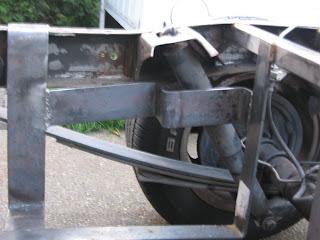I'm still busy with family activities, at work, and with various projects as a mentor of the Tahoma Robotics Club so I currently have very little time to work on this project. However, the good new is that my batteries are on order! Specifically, 50 ThunderSky 160 amp hour batteries. Initially, I plan to use 48 of them at 3.2 volts nominal each for a total of 153.6 total volts. I have been working with Manzanita Micro and they have agreed to order the batteries for me. My original plan was to order the TS batteries direct from China but I dreaded the hassle of getting them through customs. Manzanita Micro has experience ording these cells as they use them in their prius hybrid kits. So, I sent them a check and now I wait. The lithium batteries may arrive this year although it won't slow me down any if they don't since my Zilla controller won't be ready until May or June. And so I must be patient...
I created a diagram for those of you who are interested in some of the dimensions and layout of the battery boxes. The 48 ThunderSky cells will completely fill the forward twin battery boxes under the lift bed and a little over half of the rear battery box, leaving me some room for expansion in the future. With 48 of the 160 amp hour cells the total traction pack will contain over 24,000 kwh. I estimate that this will provide me with a range of 100 plus miles at my average daily driving speeds. But only time will tell...
Notice the red motors in the diagram with not tranmission. I have done a lot of research lately on the possiblity of building a direct drive system. Which basically means connecting the motor or motors directly to the drive line and eliminating the transmission completely. Many people that I have contacted say it can't or shouldn't be done while others seem to disagree. John (coworker and former race car builder/driver) and I have completed many calculations on this subject and have determined that two WarP / Impulse 9 inch motors connect in series will provide ample torque even on hills at slow speeds when controlled by my Zilla and its parallel / series capabilities. So, I am tentatively planning to move forward with this plan and may put an order in for a couple of Impulse 9 motors at the end of this year. I'll keep you posted...






















































